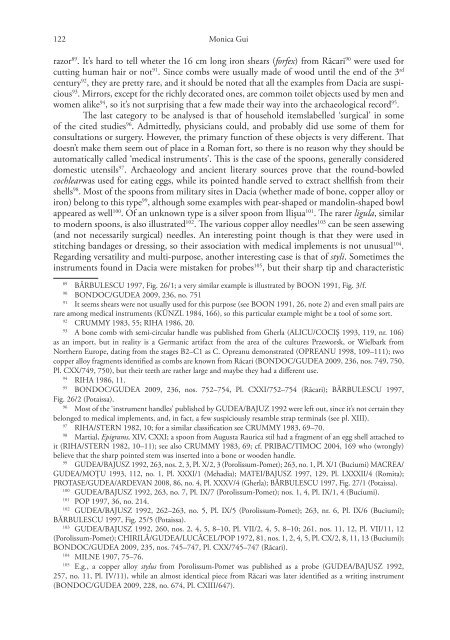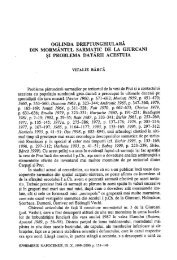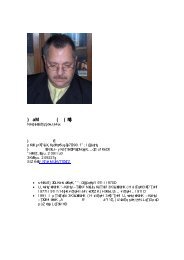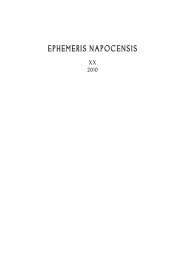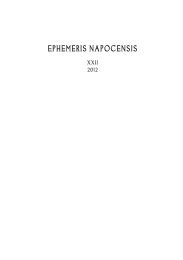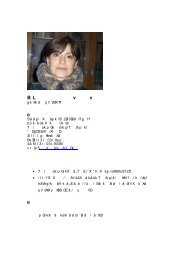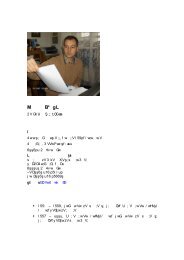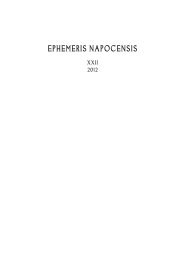ephemeris napocensis 2011 cu corectura.indd - Institutul de ...
ephemeris napocensis 2011 cu corectura.indd - Institutul de ...
ephemeris napocensis 2011 cu corectura.indd - Institutul de ...
You also want an ePaper? Increase the reach of your titles
YUMPU automatically turns print PDFs into web optimized ePapers that Google loves.
122 Monica Guirazor 89 . It’s hard to tell wheter the 16 cm long iron shears (forfex) from Răcari 90 were used for<strong>cu</strong>tting human hair or not 91 . Since combs were usually ma<strong>de</strong> of wood until the end of the 3 rdcentury 92 , they are pretty rare, and it should be noted that all the examples from Dacia are suspicious93 . Mirrors, except for the richly <strong>de</strong>corated ones, are common toilet objects used by men andwomen alike 94 , so it’s not surprising that a few ma<strong>de</strong> their way into the archaeological record 95 .The last category to be analysed is that of household itemslabelled ‘surgical’ in someof the cited studies 96 . Admittedly, physicians could, and probably did use some of them forconsultations or surgery. However, the primary function of these objects is very different. Thatdoesn’t make them seem out of place in a Roman fort, so there is no reason why they should beautomatically called ‘medical instruments’. This is the case of the spoons, generally consi<strong>de</strong>reddomestic utensils 97 . Archaeology and ancient literary sources prove that the round-bowledcochlearwas used for eating eggs, while its pointed handle served to extract shellfish from theirshells 98 . Most of the spoons from military sites in Dacia (whether ma<strong>de</strong> of bone, copper alloy oriron) belong to this type 99 , although some examples with pear-shaped or mandolin-shaped bowlappeared as well 100 . Of an unknown type is a silver spoon from Ilișua 101 . The rarer ligula, similarto mo<strong>de</strong>rn spoons, is also illustrated 102 . The various copper alloy needles 103 can be seen assewing(and not necessarily surgical) needles. An interesting point though is that they were used institching bandages or dressing, so their association with medical implements is not unusual 104 .Regarding versatility and multi-purpose, another interesting case is that of styli. Sometimes theinstruments found in Dacia were mistaken for probes 105 , but their sharp tip and characteristic89BĂRBULESCU 1997, Fig. 26/1; a very similar example is illustrated by BOON 1991, Fig. 3/f.90BONDOC/GUDEA 2009, 236, no. 75191It seems shears were not usually used for this purpose (see BOON 1991, 26, note 2) and even small pairs arerare among medical instruments (KÜNZL 1984, 166), so this parti<strong>cu</strong>lar example might be a tool of some sort.92CRUMMY 1983, 55; RIHA 1986, 20.93A bone comb with semi-cir<strong>cu</strong>lar handle was published from Gherla (ALICU/COCIȘ 1993, 119, nr. 106)as an import, but in reality is a Germanic artifact from the area of the <strong>cu</strong>ltures Przeworsk, or Wielbark fromNorthern Europe, dating from the stages B2–C1 as C. Opreanu <strong>de</strong>monstrated (OPREANU 1998, 109–111); twocopper alloy fragments i<strong>de</strong>ntified as combs are known from Răcari (BONDOC/GUDEA 2009, 236, nos. 749, 750,Pl. CXX/749, 750), but their teeth are rather large and maybe they had a different use.94RIHA 1986, 11.95BONDOC/GUDEA 2009, 236, nos. 752–754, Pl. CXXI/752–754 (Răcari); BĂRBULESCU 1997,Fig. 26/2 (Potaissa).96Most of the ‘instrument handles’ published by GUDEA/BAJUZ 1992 were left out, since it’s not certain theybelonged to medical implements, and, in fact, a few suspiciously resamble strap terminals (see pl. XIII).97RIHA/STERN 1982, 10; for a similar classification see CRUMMY 1983, 69–70.98Martial, Epigrams, XIV, CXXI; a spoon from Augusta Raurica stil had a fragment of an egg shell attached toit (RIHA/STERN 1982, 10–11); see also CRUMMY 1983, 69; cf. PRIBAC/TIMOC 2004, 169 who (wrongly)believe that the sharp pointed stem was inserted into a bone or woo<strong>de</strong>n handle.99GUDEA/BAJUSZ 1992, 263, nos. 2, 3, Pl. X/2, 3 (Porolissum-Pomet); 263, no. 1, Pl. X/1 (Buciumi) MACREA/GUDEA/MOȚU 1993, 112, no. 1, Pl. XXXI/1 (Mehadia); MATEI/BAJUSZ 1997, 129, Pl. LXXXII/4 (Romita);PROTASE/GUDEA/ARDEVAN 2008, 86, no. 4, Pl. XXXV/4 (Gherla); BĂRBULESCU 1997, Fig. 27/1 (Potaissa).100GUDEA/BAJUSZ 1992, 263, no. 7, Pl. IX/7 (Porolissum-Pomet); nos. 1, 4, Pl. IX/1, 4 (Buciumi).101POP 1997, 36, no. 214.102GUDEA/BAJUSZ 1992, 262–263, no. 5, Pl. IX/5 (Porolissum-Pomet); 263, nr. 6, Pl. IX/6 (Buciumi);BĂRBULESCU 1997, Fig. 25/5 (Potaissa).103GUDEA/BAJUSZ 1992, 260, nos. 2, 4, 5, 8–10, Pl. VII/2, 4, 5, 8–10; 261, nos. 11, 12, Pl. VII/11, 12(Porolissum-Pomet); CHIRILĂ/GUDEA/LUCĂCEL/POP 1972, 81, nos. 1, 2, 4, 5, Pl. CX/2, 8, 11, 13 (Buciumi);BONDOC/GUDEA 2009, 235, nos. 745–747, Pl. CXX/745–747 (Răcari).104MILNE 1907, 75–76.105E.g., a copper alloy stylus from Porolissum-Pomet was published as a probe (GUDEA/BAJUSZ 1992,257, no. 11, Pl. IV/11), while an almost i<strong>de</strong>ntical piece from Răcari was later i<strong>de</strong>ntified as a writing instrument(BONDOC/GUDEA 2009, 228, no. 674, Pl. CXIII/647).


